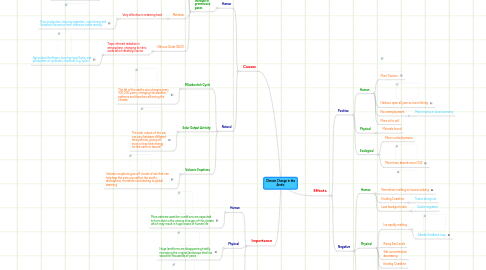
1. Causes
1.1. Human
1.1.1. Increase in greenhouse gases
1.1.1.1. Carbon Dioxide
1.1.1.1.1. Trap heat from sun within earths atmosphere
1.1.1.2. Chlorofluorocarbons (CFCs)
1.1.1.2.1. Absorbs solar radiation and thins out the ozone layer
1.1.1.3. Methane
1.1.1.3.1. Very effective in retaining heat
1.1.1.4. Nitrous Oxide (N2O)
1.1.1.4.1. Traps infrared radiation in atmosphere, changing to nitric oxide which destroys ozone
1.2. Natural
1.2.1. Milankovitch Cycle
1.2.1.1. The tilt of the earths axis changes every 100,000 years, changing the weather patterns and therefore affecting the climate.
1.2.2. Solar Output Activity
1.2.2.1. The solar output of the sun can vary between different time periods, giving off more or less heat energy for the earth to absorb
1.2.3. Volcanic Eruptions
1.2.3.1. Volcanic eruptions give off clouds of ash that can help trap the suns rays within the earths atmosphere, therefore contributing to global warming
2. Importance
2.1. Human
2.1.1. More extreme weather conditions are expected to form due to the various changes of the climate which may result in huge losses of human life
2.2. Physical
2.2.1. Huge landforms are disappearing totally recreating the original landscape that has stood for thousands of years
2.3. Ecological
2.3.1. As climate changes the wildlife must learn to adapt, yet many species cannot leading them to inevitable extinction
3. Effects
3.1. Positive
3.1.1. Human
3.1.1.1. More Tourism
3.1.1.2. Harbour open all year so more fishing
3.1.1.3. No unemployment
3.1.1.3.1. More money in local economy
3.1.1.4. More oil to sell
3.1.2. Physical
3.1.2.1. Minerals found
3.1.3. Ecological
3.1.3.1. More cod and prawns
3.1.3.2. More trees absorb more CO2
3.2. Negative
3.2.1. Human
3.2.1.1. Permafrost melting so houses sinking
3.2.1.2. Eroding Coastline
3.2.1.2.1. Towns being lost
3.2.1.3. Less food gor Inuits
3.2.1.3.1. Ducks migrated
3.2.2. Physical
3.2.2.1. Ice rapidly melting
3.2.2.1.1. Albedo feedback loop
3.2.2.2. Rising Sea Levels
3.2.2.3. Salt concentration decreasing
3.2.2.4. Eroding Coastline
3.2.2.5. Less ice to reflect suns rays
3.2.3. Ecological
3.2.3.1. Salmon dying from increasing parasite population
3.2.3.2. Polar bear population decreasing
3.2.3.3. Birs migration plans are unusual
